Course:PHYS341/2022/Project7
Experimenting with the Human Voice
This page will describe how exactly we are able to sing and make noises with our mouths, and explores/analyzes different voice types and ranges.
How it Works: The Basics of the Human Voice
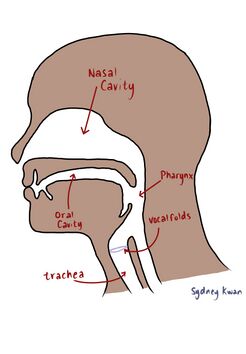
Like many other instruments, the human voice has a “cavity” also known as the tube or body of an instrument which has standing wave oscillations inside of it. The cavity of the human voice is the vocal tract which includes the nasal cavity, the oral cavity or your mouth, and the pharynx located in the throat (Figure 1). This means when you are speaking or singing, the oscillations exist within this “cavity” or area of your body. This leads to sound waves being projected outside of your body through your mouth and nose. The “cavity” of the human voice is more like the body of a violin rather than a wind instrument because it can support many different vibration frequencies.
There is also something that drives those oscillations. For a wind instrument like the saxophone, there is a reed to drive oscillations and for a flute, there is an air jet. For the human voice, there is something called the vocal folds, more commonly referred to as vocal cords. When you are breathing, the two vocal folds open up to the sides of your throat and leave a big opening called the “glottis”. The folds can also be closed, which is what happens when we sing or speak, and the two sides will come together to meet in the middle of your throat. In this position, they operate very similarly to a pair of lips playing a brass instrument. The pressure inside your windpipe increases until it’s enough to force the vocal folds open. Naturally, the folds will want to come back together. When the air is moving through the vocal folds, the pressure decreases, and the vocal cords return to the original position.
We have control over the frequency of the oscillations through the muscles in and around our vocal folds. There are specifically two types of muscles that help us do this. The “vocalis muscle” located inside the vocal fold, contracts which causes the folds to shorten and stiffen. After air passes through, the stiff folds will want to come back together more quickly, resulting in a higher frequency oscillation. The “cricothyroid muscles” are outside of the vocal folds. These muscles stretch the folds from the outside to become longer and tighter, like pulling on a rubber band, also producing a higher frequency.


Types of Singing Registers
There are two types of ways we can control our voice.
Modal Register (M1)
The first is the Modal Register (M1), also known as “chest voice”, which uses both types of muscles that were mentioned above. Using the Modal Register for lower notes utilizes the vocalis muscle and the vibration frequency increases as it stiffens. As you move up higher in the Modal Register, you begin using the cricothyroid muscles as well. This means your vocal folds are stiffening and being stretched at the same time, which increases the frequency even more. This combination produces rich tones because the folds are more tightly closed, creating more harmonics. This also results in a sound wave that is less sinusoidal (Figure 2).
Falsetto Register (M2)
The second is the Falsetto Register (M2), sometimes referred to as “head voice”. With this type of singing, the vocalis muscle is relaxed and only the cricothyroid muscles are being used to stretch the vocal folds from the outside. The folds do not shut all the way and are closed for less of the cycle. Less harmonics results in a breathier tone in comparison to what it sounds like to sing in the Modal Register. Because there are less harmonics when singing in falsetto, it is more similar to a pure tone. This means that the sound wave of a note sung in Falsetto will look more sinusoidal (Figure 2.1).

Comparing the Registers
I tried my best to record a an A4 note in the Modal Register and in the Falsetto Register to compare their spectrum graphs (Figure 2.2).
There is a noticeable difference in formants for both sound spectrums. The Modal Register has a lot more higher frequencies while the Falsetto Register has less and are not as prominent. This shows us visually why the Modal register sounds more rich than the Falsetto register.
Timbre and Range
What is Timbre?
Everyone has a unique timbre to their voice, speaking and singing.
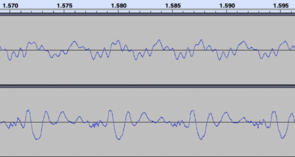
Timbre refers to the character or quality of a voice or musical sound. The way the throat muscles stiffen and stretch the vocal folds has an impact on the timbre of the voice. This also relates to the shape of a sound wave. For example, an alto saxophone's sound wave would have different shape than a guitar's sound wave because they have different timbres.
There are also different ranges that a person can be comfortable singing in. The range of singing voices can be categorized from low to high as bass, baritone, tenor, alto, mezzo-soprano, and soprano.
With the help of the members in the UBC A Cappella group The Unaccompanied Minors, I was able to compare the sound waves of some of our voices to each other.
I, an alto, sang a C note on an "ah" vowel (top) and a tenor sang the same thing (bottom) (Figure 3). The shape of the top sound wave is different from the bottom because the timbres are different.
Why Do People Have Different Ranges?
The range that I can comfortably sing at is higher than that of a tenor and lower than a soprano's range. That is because of the varying sizes, lengths, and tension of the vocal folds from person to person. It is the one thing that singers, or anyone for that matter, have no control over. Most children have similar sized vocal cords which is why they have similar higher pitched vocal ranges. As you get older, your vocal folds grow longer, which gives adults a much lower vocal range than children. Upper voices usually have vocal cords around 12.5 millimeters (mm) and 17.5 mm long. Lower voices have longer vocal cords than upper voices, between 17 mm and 25 mm in length.[1]
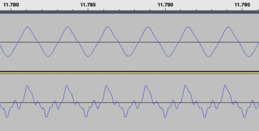
Comparing Voices
Tenor Vs Alto
What if a tenor sang a note that is considerably high for them but was in a comfortable range for an alto singer? (Figure 4)
I had a tenor voice sing a G4 in the Modal Register on an "oo" vowel. I recorded myself singing the same thing. The sound wave that I produced is much more sinusoidal than the tenor voice's. This must mean that not only are our timbres different, but the harmonics we are producing are being emphasized differently.
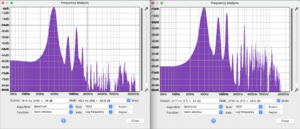
Looking at their spectrum graphs (Figure 4.1), we can see that the tenor (right) has more formants and they are more prominent compared to the alto voice (left).
Bass' Lowest Note and Soprano's Highest Note
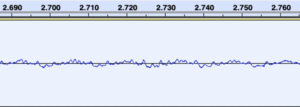
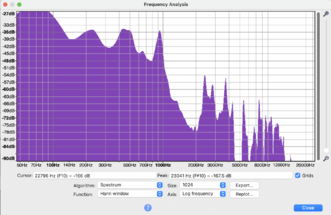
As someone who doesn't have a very high or low range, I was curious to see what a bass' lowest note and a soprano's highest note looked like.
I asked a bass to record a D2 note on an "oh" vowel, which is at the very low end of his range (Figure 4.2, 4.2.1). You can listen to that here:
I asked a soprano to record an E6 note on an "oh" vowel as well, at the top end of her range (Figure 4.3, 4.3.1). You can listen to that here:
I find it really interesting to see how much this sound wave is like a sinusoidal wave and how pure the sound is from the information in the spectrum graph.
The D2 note looks and sounds like a thicker sound while the E6 sounds more like a whistle and has a thinner sound.


One Voice Vs A Group of Voices
What if multiple people are singing the same note altogether? How would that look different from a graph of one person singing by themselves?
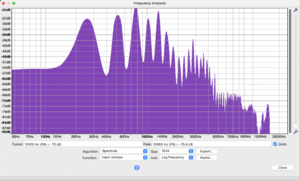

First, I had a group of 12 people sing the same note together. There was a mix of upper voices and lower voices.
Then, I sang the same note by myself and compared the spectrum graphs.
In Figure 5 and 5.1, it is evident that the group of people singing has a richer sound in comparison to one person singing alone. This is because of all the different tones and qualities of the voices together, as well all of the different formants of each person's voice combined.
I also had each section sing a note in a C chord (C, E, G) (Figure 4.4, 4.4.1) so that I could compare it to the group singing the same note.
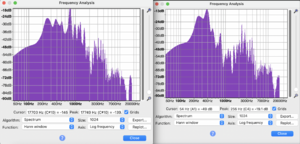

It's interesting how different the spectrum graphs look of the same note and a chord. I think it's also interesting when the vowel changes, certain formants are more emphasized than before. The nicest sounding C chord in my opinion is the one sung with an "oo" vowel because the blend of all our voices together sounds very cohesive.
References
- ↑ "Singing Science: How High and Low Can You Go?". Scientific American.
(will be formatted properly) https://www.scientificamerican.com/article/singing-science-how-high-and-low-can-you-go/